
Table 1: Distribution of respondents according to level of study and school


Simiyu N Benjamin1* Loice W Gathece2 Evelyn G Wagaiyu2
1Department of Conservative and Prosthetic Dentistry School of Dental Sciences, University of Nairobi, Kenya*Corresponding author: Simiyu N Benjamin, Department of Conservative and Prosthetic Dentistry School of Dental Sciences, University of Nairobi, Kenya, Tel: +254727200965; E-mail: savedbenja@yahoo.com
Objective: The aim of the study was determining knowledge, attitude and use of mouthwash among dental and medical students.
Study design: This was a descriptive cross sectional study.
Setting: The School of Dental Sciences and the School of Medicine of the University of Nairobi.
Subject: All undergraduate students admitted in the schools of medicine and dentistry.
Study methodology: A stratified random sampling method was used.
Results: A majority (95%) of Dental students and 87.5% Medical students knew about mouthwashes. Ninety-two percent Medical and 87% Dental students would advise other students on mouthwash. Only 39% of the students brushed their teeth twice daily while 61% brushed once. From Dental School, tooth brushing at least twice a day was claimed by 27.5% while 72.5% students said they brushed only once per day. Only 16.3% of the Dental students and 12.5% Medical students practiced the use of mouthwashes while 37.5% Medical and 33.8% Dental students never used mouthwash.
Conclusion: Dental students had adequate knowledge about mouthwashes. They practiced the use of mouthwash more than the Medical students. Students from both schools were knowledgeable on what mouthwash is. They also wanted to positively influence other students to practice the use of mouthwash.
Mouthwash; Students; Knowledge
Oral health is the pathway to one’s general health and wellness. Dental health cannot be separated from general health. Many systemic diseases show their early signs in the oral cavity, thereby making the knowledge of oral tissues invaluable for any medical professional. The behavior of oral health providers and their attitudes towards oral health could affect their capacity to deliver oral health and thus might affect the oral health of their patients [1,2]. Mouthwash is a product used as an adjunct to oral hygiene practices as an antiseptic and anti-plaque agent.
Periodontal diseases arise from the production of noxious products by the entire plaque flora but only certain plaque is pathogenic and this is dependent on the presence or increase in specific microorganisms. Inhibition of this plaque formation by the use of mouthwash will inhibit gingival inflammation and subsequently by extension periodontitis [3]. Mouthwashes claim to kill the bacterial plaque which causes periodontal diseases, dental caries, and bad breath. Anti-cavity mouth rinses use fluoride to protect against tooth decay. However, it is generally agreed that the use of mouthwash does not eliminate the need for both toothbrush and flossing [4].
The different types of mouthwashes include Fluoride rinses, Chlorhexidine and Povidine iodide mouthwashes among others. Active ingredients in commercial brands of mouthwash can include thymol, eucalyptol, hexetidine, methyl salicylate, menthol, chlorhexidine gluconate, benzalkonium chloride, cetylpyridinium chloride, methylparaben, hydrogen peroxide, domiphen bromide and sometimes fluoride, enzymes and calcium. Ingredients also include water, sweeteners such as sorbitol, sucralose, sodium saccharine, and xylitol (which doubles as a bacterial inhibitor). The indications of mouthwashes include: in the treatment of gingivitis, periodontitis, halitosis and in the maintenance of oral hygiene, particularly following periodontal and other oral surgical procedures or in mentally or physically handicapped patients.
They also reduce the duration and severity of both aphthous ulceration and oral ulceration caused by mechanical or chemical injuries e.g. orthodontic appliances. The common use involves rinsing the mouth with about 10-15ml of mouthwash two times a day after brushing, in the morning and at night for the best results. The mouthwash is typically swished or gargled for about half a minute and then spat out [5].
The side effects of mouthwashes include burning sensation in the cheeks, teeth and gums [6]. Children may swallow mouthwash during use and this may lead to alcohol poisoning or fluoride overdose [6]. Recently, some studies have alluded to the possible carcinogenic character of the alcohol used in mouthwashes as a carrier for the flavor, to provide “bite”, and to contribute an antibacterial effect [6]. Several studies have been carried out regarding the oral hygiene behavior of dental students in many countries like Tunisia,[7] Japan, [8] Romania [9] among others. They have shown a progression towards better oral hygiene amongst dental students along with their academic progress and they all showed a remarkable improvement when the students switched to their clinical practice.
Studies on the knowledge, attitude and behavior of university students towards oral health have been sparse and have primarily been conducted among dental or dental hygiene or medical students [10-12]. Furthermore, there are no studies that compare the use of mouthwashes by medical and dental students in Kenya.
A recent oral health survey in Kenya revealed that oral health seeking behavior of the population was poor. Amongst an adult population, almost all of them (98.1%) had signs of gingivitis. The prevalence of dental caries among the adult population was 34.3%. On average, every adult had one decayed tooth with a DMFT of 0.72. This implies that there is a very high unmet treatment needs for gingivitis and dental caries in Kenya [13].
A Jordan study among 557 students revealed that 6% of them used mouthwashes though majority of them did not have enough knowledge on mouthwashes, 2% reported using dental floss, and 7% reported using tooth pick as extra aids for oral hygiene [14]. Another study by Zhu et al. 2003 [15] revealed that 44.4% of the respondents brushed their teeth at least twice a day but only 17% used mouthwashes. Nearly half of the participants (47.2%) had never received any oral health care instruction on mouthwashes [15].
A study by Kumar et al. [16] revealed that there is a significant difference between the oral hygiene behavior and caries status of dental and medical students; furthermore, caries status is significantly influenced by the oral hygiene behavior. In this study, 56.4% of dental students brushed their teeth twice daily compared to 38.5% of medical students. The mean behavior score obtained by dental students (19.38) was greater than that of medical students (18.34). Moreover, medical students presented a higher decayed, missing and filled teeth (DMFT) score (1.96) than dental students (1.16). Subjects who had a habit of brushing after every meal showed lower DMFT score (1.4) than those who brushed only once a day (1.64) [16].
The aim of this study was to determine the knowledge, attitude and practice of mouthwash use among dental and medical students of the University of Nairobi, Kenya. The results may then be used to design programs for increasing the knowledge on mouthwashes among the students. As a result, this knowledge will be passed over to the community as a means of enhancing the prevention of dental caries and periodontal disease.
This was a descriptive cross sectional study conducted at the school of dental sciences and the school of medicine of the University of Nairobi. This study included medical and dental undergraduate students of the University of Nairobi. A stratified random sampling method was used to select subjects from the School of Dental Sciences and the School of Medicine. Since the sample size was 80, 40 Students were picked from the School of Dental Science and 40 from the School of Medicine. This was then distributed equally among the different levels in each year. The School of Dental Sciences had four levels (years of study i.e. Level I to Level IV), while the School of Medicine had five levels of study (Level I to Level V).
A self-administered questionnaire was used to collect data. The questionnaire was administered by the interviewer and collected back once the students filled the required information. The data was analyzed using the SPSS version 20 and MS EXCEL. Cross tabulation was used to compare different variables. The data has been presented by use of charts, graphs, tables and texts.
The 80 respondents recruited in the study included 50% dental students and 50% medical students who correctly responded to the questionnaires. There were 46% males and 54% females (Figure 1). From the School of Dental Sciences, 47.5% were males and 52.5% females. 25.0% were first years, 25.0% were second years, 25.0% were third years and 25.0% were level fours (Table 1). There were no fifth year students at the school of Dental Science. From the School of Medicine, 45.0% males and 51.2% females participated in the study (Figure 1). 20.0% were first years, 20.0% were level twos, 20.0% level threes, 20.0% level fours and 20.0% were in their fifth year of study.

Table 1: Distribution of respondents according to level of study and school
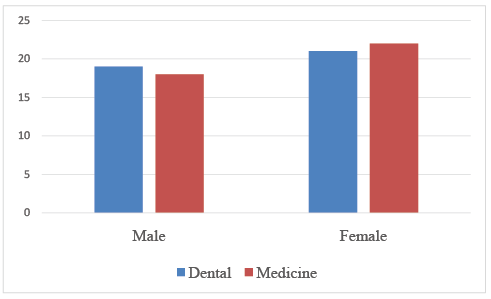
Figure 1: Gender distribution by school
When the students were asked how often they brush, 61% said they brushed only once per day, while 39% said that they brushed at least twice a day. From Dental School, 27.5% students said they brushed at least twice per day while 72.5% students said they brushed only once per day. From Medical School, 50%students said they brushed at least twice per day while 50%said they brushed only once a day (Figure 2).
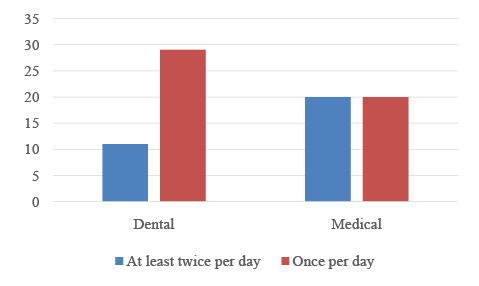
Figure 2: Oral hygiene practices by school
On the aids of tooth cleaning, 78.0% of the correspondents used conventional toothbrush and toothpaste, 11.0% used dental floss as an adjunct to brushing. Those who used mouthwash as an adjunct to brushing were 7% while 4% combined all the mentioned aids of tooth cleaning (conventional toothbrush, toothpaste, mouthwash and dental floss (Figure 3).
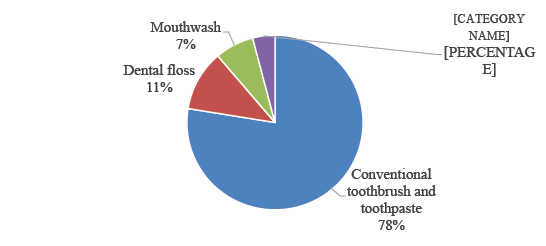
Figure 3: Aids of brushing
Of the 80 students, 95% dental students knew mouthwash as an oral hygiene, antiseptic and anti-plaque agent while only 5% said that it is a fluid use to wash the mouth. From the Medical School, 87.5% said that mouthwash is an oral hygiene, antiseptic and anti-plaque agent while 12.5% said it is a fluid use to wash the mouth.
When questioned on whether they knew any dental disease that can be prevented by use of mouth wash, 87.5% dental students knew of a disease while 12.5% students did not know of any disease. Among those who said that they knew of a dental disease that can be prevented by mouthwash, 55.9%, 44.1% and 29.4% students knew periodontitis, gingivitis and dental caries respectively. From the Medical School, 67.5% students knew of a disease while 32.5% students did not know of any disease that can be prevented by use of mouthwashes. Among those who said that they knew of a dental disease that can be prevented by mouthwash, 33.3%, 29.6% and77.8%, medical students were aware of periodontitis, gingivitis, and dental caries respectively (Table 2).

Table 2: Knowledge of dental diseases by school
Mouthwash had been recommended to 32% dental and41% medical students. 68% dental and 59% medical students had not had mouthwash recommended to them. Among those to whom mouthwash had been recommended, 70% were recommended by a medical doctor while 30% were recommended by a Dentist (Figure 4).
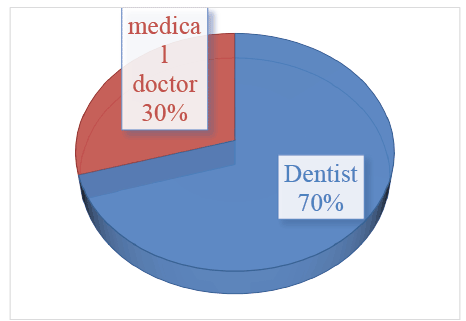
Figure 4: The recommender of mouthwash
When asked why the mouthwash was recommended 33% reported it was to treat sore throat, 30% said it was for a dental disease, 22% said it was recommended after surgery while 15% reported that it was for bad breath. Concerning whether the use of mouthwashes is harmful to teeth and gum, 78.5% of the students said yes while 21.5% declined. Among those who said yes, 18% were medical students while 25% were Dental students. 82% medical students and 75% dental students said that mouthwashes have no detrimental effect on teeth and gum. Among the students who said that mouthwashes did not harm the mouth, 53% simply said that there is no effect at all. 23% said that mouthwashes suppress normal flora hence has effect on teeth and gum. 10% said mouthwashes cause staining of teeth and another 10% said that mouthwashes have side effects only when overused. Only 4% said that mouthwashes elicit a burning sensation in the mouth (Figure 5).
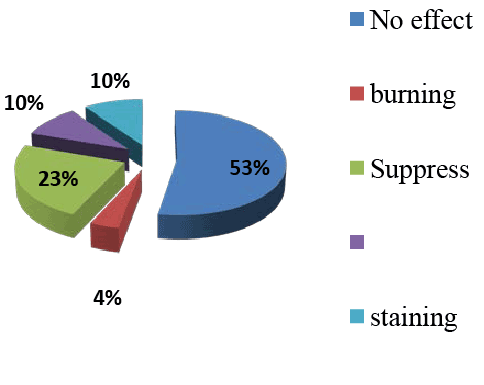
Figure 5: Effects of Mouthwash
When questioned whether they practiced the use of mouthwash, 29% of both dental and medical students used mouthwash while 71% did not practice the use of mouthwash. Among those who practiced the use of mouthwash, 32.5% were dental students and 25% were medical students. Those who did not practice the use of mouthwash were 67.5% and 75%dental and medical students respectively (Figure 6).
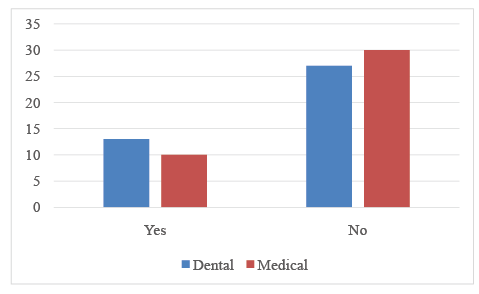
Figure 6: The practice of the use of mouthwash by school
When asked which type of mouthwash that they used, 41% of the respondents used Betadine mouthwash, 36% of the respondents used Listerine mouthwash, 14% used Chlorhexidine while only 9% used Colgate mouthwashes (Figure 7). When asked on how often they practiced the use mouthwash, 44%, 17%, 17% used mouthwash weekly, daily and more than three times per week respectively while 22% used mouthwash other times.
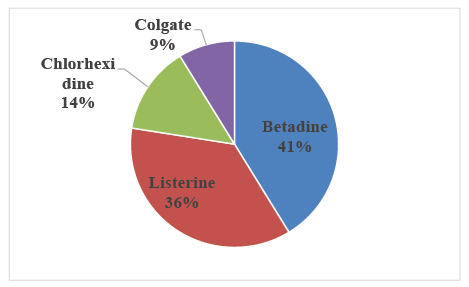
Figure 7: Type of mouthwash
Among those who practiced the use of mouthwash, 43.5% used mouthwash after brushing while 21.7%, 21.7%, 8.7% and 4.3% used mouthwash after meals, before going to bed, other times and before tooth brushing respectively (Figure 8). Among the respondents who did not practice the use of mouthwash, 47% said that mouthwash was not necessary, 27%, 24% and 2% said that it is expensive, they knew little about mouthwash and brush and dental floss is enough respectively.
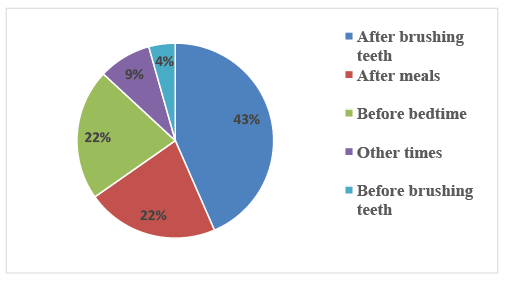
Figure 8: Time of practice of mouthwash
When asked where they could get mouthwash, 45% dental students and 36.4%medical students said from supermarket, 16% dental and 20.8% medical students said from dental clinic, 10% dental and 15.6% medical students said from a hospital while 29% dental and 35.1% medical students said they could get from a pharmacy. Concerning whether they would advise other students to use mouthwash, 92% medical and 87% dental students said they would while 13% dental and 8% medical students would not (Figure 9). Among those who said that they would advise other students to use mouthwash, 73.4% thought it improves oral hygiene status and 9.4% thought it prevents periodontal diseases. As to those who could not advise others to use mouthwash 6.3%, 3.1%, 3.1%, 1.6%, 1.6% and 1.6% said that it was dependable, mouthwash substitutes brushing, brushing was enough, it is risky, it is expensive and it was not necessary respectively.
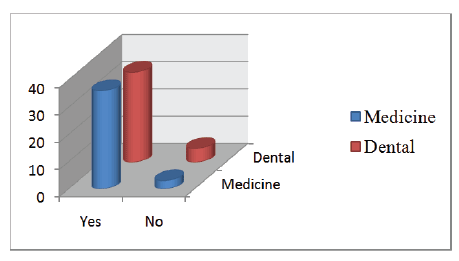
Figure 9: Response as to advise or not to advise other students by school
There were more females than males recruited in the study. This could be attributed to the fact that there are more female students admitted in the School of Medicine and the School of Dental surgery. The majority of respondents thought mouthwash is an oral hygiene, antiseptic and anti-plaque agent with only 95% being Dental Students and 87.5% being Medical Students. This is in contrast with a Jordanian study where mouthwash was not well known among the students due to lack of proper knowledge.14In addition, this could be because they were Primary School Pupils compared to the Dental and Medical Students who are University Students in the tertiary level of education and may have learned about mouthwashes somewhere along the way.
Concerning the knowledge on dental diseases that can be prevented by mouthwash, 55.9%, 44.1% and 29.4% Dental Students knew periodontitis, gingivitis and dental caries respectively while 33.3%, 29.6% and 77.8%, Medical Students were aware of periodontitis, gingivitis, and dental caries respectively. Thus many Dental students than Medical Students knew of periodontitis and gingivitis as diseases that could be prevented by use of mouthwash. This can be attributed to the provision of knowledge among students in the dental field and a better approach towards dental health issues than the medical students. This is in contrast to Sgan-Cohen HD et al study, 1999 where 68.5% of the school teachers were aware of the anti-bacterial role of mouthwashes, and only a small minority knew of mouthwash potential in healing incipient caries [17].
Responses concerning advice of use of mouthwashes to other students confirmed positive attitudes towards use of mouthwashes among Medical Students (92%) compared to Dental Students (87%). This is in contrast with Sgan-Cohen HD et al. study, 1999 where teachers seemed less motivated to being involved in dental health school programs which involved dedicating school time and their active involvement, such as school mouth rinsing programs, fissure sealant programs at school and supervision of brushing and flossing [17]. On the part of the teachers, their lack of knowledge seemed to be a major obstacle in fulfilling this role unlike the majority of the medical and dental Students who have a lot of knowledge acquired from class work and are willing to motivate others to use mouthwashes.
Only 16.3% dental students and 12.5% medical students practiced the use of mouthwashes while 37.5% medical and 33.8% dental students never used mouthwash. This is in contrast with the Jordanian study where only 6% of the pupils practiced the use of mouthwash [14]. This number of pupils who practiced the use of mouthwash is low compared to both Dental and Medical Students because they also lacked knowledge on mouthwashes as observed earlier on. In another study by Zhu L et al. only 17% of the respondents used mouthwashes [15]. Concerning the types of mouthwashes they used, 41% of the respondents used Betadine mouthwash, 36% used Listerine mouthwash, 14% used Chlorhexidine mouthwash, while only 9% used Colgate mouthwash. There was no gender predilection neither did the school of study matter.
In comparison with medical students, more of the dental students were found to brush twice daily. The impact of dental literature may be considered as the reason for this. Similar findings were observed among medical and dental students of India [16]. The number of students who practiced brushing twice daily in this study was lower in contrast with the Zhu L et al. study where 44.4% of the respondents brushed their teeth at least twice a day with only 17% using fluoridated toothpaste [15].The number of those who practiced brushing at least twice per day seems higher in the Zhu L et al. study because of the regular visits for check-ups by the respondents since it was done in a well-developed country unlike Kenya which is a developing country and many students cannot afford to visit a dentist for regular check-ups where they could be advised on the number of times to brushing.
The number of students from Medical School who brushed twice per day was equal to those who brushed once per day. From Dental School, only 27.5% students said they brushed at least twice per day while 72.5% of the students said they brushed only once per day. Therefore, Medical students practiced tooth brushing more often than Dental students. This may be because, unlike medical students, Dental Students are aware of alternative means of maintaining their oral hygiene other than brushing.
This study clearly showed that females from both the courses showed better oral hygiene practices than males and were found to be more aware of oral hygiene practices. Gender-specific studies conducted earlier also showed similar results [16,18].
Only 51.6% Females brushed their teeth twice or more than twice a day compared to 48.4% males. It is important to note that the practice of tooth brushing is better in female subjects than males. This could be attributed to the fact that female students have a better approach towards dental health issues than male students.
In comparison to an oral health survey in Kenya, where 72.1% of the population used conventional toothbrush, this study revealed 78% of the population using conventional toothbrush to clean their teeth.13 Only 50% dental students used dental floss to practice interdental cleaning compared to only 11.1% medical students. 22.2% medical students used mouthwash while only 11.1% dental students used mouthwash. It can be concluded that medical students practiced the use of mouthwash more often than dental students.
In this study, students demonstrated equal knowledge on where they could find a mouthwash. The school did not matter neither did the gender. Mouthwash had been recommended only to 36.7% of the students while 63.3% of the students did not have any recommendation. This is in contrast to Zhu L et al. study where nearly half of the respondents (47.2%) had never received any recommendations on use of mouthwash [15]. When asked who recommended mouthwash to them, 70% were recommended by a medical doctor while 30% were recommended by a Dentist. Therefore, Medical Doctors recommend mouthwashes more often than Dentists. This may be because Dentists may prescribe supplemental means of promoting oral health to their patients other than mouthwashes. It is of great importance that the future dental surgeon, whose duty will be to motivate the patients and to give them all the basic instructions to enable them to achieve a sufficient degree of oral hygiene, should themselves be particularly conscious of the pathological effects of a poor oral hygiene and recommend the use of mouthwash [19].
From the findings, it can be concluded that in general, Dental Students have adequate knowledge about mouthwashes. However, they need motivation to use the mouthwashes. Considering that Medical Students will be future doctors and have a social responsibility to the community’s general health, it is then important that they should have sufficient knowledge, proper attitude and practice of the use of mouthwashes. There is a need to provide more health education to male subjects to improve their oral health. Educational seminars should be arranged for students in both schools to inform them of the different types of mouthwashes available in the market currently and their side effects.
Authors are grateful to the subjects who participated in the study and the ethical committee of the University of Nairobi/KNH for their kind support throughout the study period.
Download Provisional PDF Here
Article Type: Research Article
Citation: Benjamin SN, Gathece LW, Wagaiyu EG (2016) Knowledge, Attitude and Use of Mouthwash among Dental and Medical Students of the University of Nairobi. Int J Dent Oral Health 2(5): doi http://dx.doi.org/10.16966/2378-7090.198
Copyright: © 2016 Benjamin SN, et al. This is an open-access article distributed under the terms of the Creative Commons Attribution License, which permits unrestricted use, distribution, and reproduction in any medium, provided the original author and source are credited.
Publication history:
All Sci Forschen Journals are Open Access